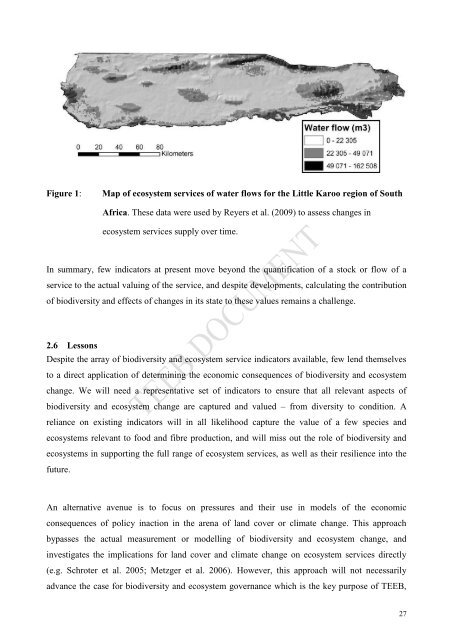Chapter 3 Measuring biophysical quantities and the use of ... - TEEB
Chapter 3 Measuring biophysical quantities and the use of ... - TEEB
Chapter 3 Measuring biophysical quantities and the use of ... - TEEB
Create successful ePaper yourself
Turn your PDF publications into a flip-book with our unique Google optimized e-Paper software.
Figure 1:Map <strong>of</strong> ecosystem services <strong>of</strong> water flows for <strong>the</strong> Little Karoo region <strong>of</strong> SouthAfrica. These data were <strong>use</strong>d by Reyers et al. (2009) to assess changes inecosystem services supply over time.In summary, few indicators at present move beyond <strong>the</strong> quantification <strong>of</strong> a stock or flow <strong>of</strong> aservice to <strong>the</strong> actual valuing <strong>of</strong> <strong>the</strong> service, <strong>and</strong> despite developments, calculating <strong>the</strong> contribution<strong>of</strong> biodiversity <strong>and</strong> effects <strong>of</strong> changes in its state to <strong>the</strong>se values remains a challenge.2.6 LessonsDespite <strong>the</strong> array <strong>of</strong> biodiversity <strong>and</strong> ecosystem service indicators available, few lend <strong>the</strong>mselvesto a direct application <strong>of</strong> determining <strong>the</strong> economic consequences <strong>of</strong> biodiversity <strong>and</strong> ecosystemchange. We will need a representative set <strong>of</strong> indicators to ensure that all relevant aspects <strong>of</strong>biodiversity <strong>and</strong> ecosystem change are captured <strong>and</strong> valued – from diversity to condition. Areliance on existing indicators will in all likelihood capture <strong>the</strong> value <strong>of</strong> a few species <strong>and</strong>ecosystems relevant to food <strong>and</strong> fibre production, <strong>and</strong> will miss out <strong>the</strong> role <strong>of</strong> biodiversity <strong>and</strong>ecosystems in supporting <strong>the</strong> full range <strong>of</strong> ecosystem services, as well as <strong>the</strong>ir resilience into <strong>the</strong>future.An alternative avenue is to focus on pressures <strong>and</strong> <strong>the</strong>ir <strong>use</strong> in models <strong>of</strong> <strong>the</strong> economicconsequences <strong>of</strong> policy inaction in <strong>the</strong> arena <strong>of</strong> l<strong>and</strong> cover or climate change. This approachbypasses <strong>the</strong> actual measurement or modelling <strong>of</strong> biodiversity <strong>and</strong> ecosystem change, <strong>and</strong>investigates <strong>the</strong> implications for l<strong>and</strong> cover <strong>and</strong> climate change on ecosystem services directly(e.g. Schroter et al. 2005; Metzger et al. 2006). However, this approach will not necessarilyadvance <strong>the</strong> case for biodiversity <strong>and</strong> ecosystem governance which is <strong>the</strong> key purpose <strong>of</strong> <strong>TEEB</strong>,27
















